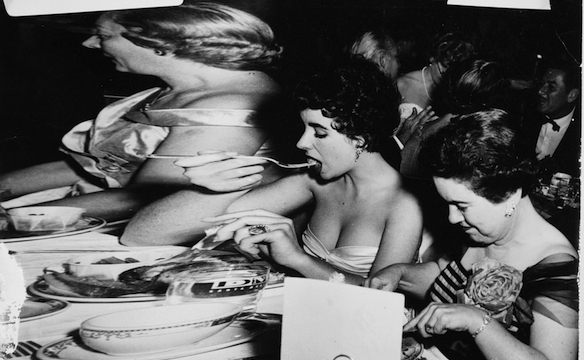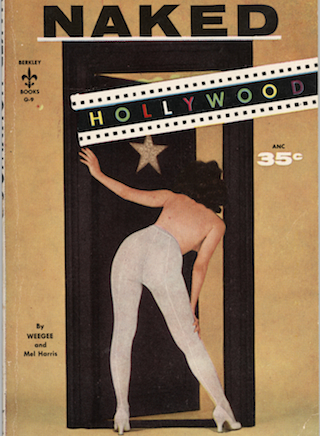
"Pacific Standard Time," the sprawling multivenue consideration of Los Angeles art from 1945 to 1980, is, for the most part, a story of artists who thrived here. However, "Naked Hollywood: Weegee in Los Angeles," which opened Nov. 13 at MOCA Grand Avenue, posits a different narrative, recounting the famed New York photographer's sojourn in Los Angeles between 1947 and 1952 as a somewhat soured love affair. If Hollywood is indeed a boulevard of broken dreams, then the Weegee show is our tour guide.
As, Richard Meyer, an associate professor of art at USC and the exhibition's curator, recalled, MOCA director Jeffrey Deitch's first suggestion to him for the region-wide initiative "Pacific Standard Time: Art in L.A. 1945-1980" was to organize a photo show of "anything but high art" images - street photography, advertising, publicity. Meyer worried that that mandate was impossibly broad, so, instead, remembering that Weegee had produced a book, "Naked Hollywood," he suggested they look at the Weegee archive at New York's International Center for Photography. The book showcases 150 images, but they found more than 1,000 in the archives, some never published. Meyer saw a story in the images, and Deitch quickly agreed to the show.
"Basically, once I said the title, 'Naked Hollywood,' I had him," Meyer said.
Weegee was born Usher Fellig in 1899 in Zloczow, Poland (now known as Zolochiv, Ukraine). When his family arrived at Ellis Island a decade later, his first name was changed to Arthur. As a teenager living on the Lower East Side, he dropped out of school to help support his family. By the 1920s, he was working in a professional darkroom, and, by the mid-1930s, he had become a freelance photographer for a number of tabloid newspapers. In Weegee's telling, his uncanny ability to arrive at crime scenes, sometimes even before the police, led to his nickname "Weegee," a phonetic spelling of Ouija, like the fortune-telling board.
For many years, newspapers like the New York Times rejected Weegee's photographs. However, after The Museum of Modern Art purchased several of his photographs and exhibited them, his reputation grew. In 1945, Weegee published "Naked City," a collection of images that became, Meyer said, "a surprise best-seller." Producer Mark Hellinger purchased the film rights for the then-princely sum of $3,000. In 1947, Weegee arrived in Los Angeles, the self-proclaimed "Genius of the Camera," intending to leave behind tabloid crime scene photography to launch a career as an actor, filmmaker, photo consultant, photographer and celebrity in his own right.

It seems only natural that Weegee, a self-made Jewish immigrant and shameless self-promoter, should expect to find success in the very place Central European immigrants had established what Weegee called "the Dream Factory." A place where landsmen such as Billy Wilder and Michael Curtiz already had made their fortunes. But, as Primo Levi once famously remarked, "Life proved otherwise."
Weegee's arrival in Hollywood, by his own account, was feted by Gene Kelly and acclaimed by Charlie Chaplin. But the first indication that Weegee's ambitions might not be realized came when the movie adaptation of his book appeared, titled "Mark Hellinger's 'Naked City,' " with no marquee or title credit for the photographer. Weegee spent the next four years in Los Angeles photographing premieres, stars and starlets, strippers and showgirls, mannequins and masks, as well as acting in films (he joined the Screen Actors Guild), consulting on movies, making short films and, as always, relentlessly promoting himself. He inserted himself into photos and developed experimental images, shot with distorting plastic lenses and with images repeated or inserted for special effect, to give voice to his increasingly sour view of Hollywood.
In no time, Weegee began referring to Los Angeles as "Newark, New Jersey, with palm trees" and "land of the zombie." It's hard not to see this as a protective film (literally and figuratively) for a man who craved fame and acceptance for the very idiosyncratic style that made him an outsider and his work unique.
Weegee was drawn not just to celebrity, but to the fans, to the candid moments backstage rather than what was on stage, to the sideshow of drunks and skid-row denizens, stars at their least glamorous moments - such as midmeal or resting before a performance. As he once remarked, "I have no inhibitions, and neither has my camera. What may be abnormal to you is normal to me."
It was only upon his return to New York that Weegee, with the help of the writer and designer Mel Harris, culled through his work to produce "Naked Hollywood." The photos are laid out to show contrasts -- a photo of a chimp eating is juxtaposed with one of young Elizabeth Taylor midbite -- and with ironic or witty captions. A photo of a window display featuring "extra-large panties" is titled "Wardrobe dept."
The book, however, did not match the success of "Naked City," and, over time, Weegee's Los Angeles adventure receded behind the legend of his New York work.
Until now.

MOCA's exhibition is organized into nine thematic rooms: "Premiere," "Stars," "Magazines," "Newark With Palm Trees" (including images of shop windows, advertisements and signs), "Showgirls," "Photography Is Elastic" (a showcase of Weegee's distorted portrait images), "Bit Parts" (Weegee's appearances in his own photographs, on sets and on film), "Fraymart Gallery" (a re-creation of a group photography show that included Weegee's work) and "Dream Factory."
Meyer admitted that although he had been aware of Weegee's L.A. work, it was only through exploring these images that he came to see Weegee "as more thoughtful about Hollywood."
Jason Goldman, who assisted Meyer in curating the show, said he was struck by "the extent to which he [Weegee] relied on words." Indeed, Weegee's captions and handwritten annotations render the photographs into ironic social commentary, delivering, as Goldman noted, "a conceptual layer to his work."
Nonetheless, the distortions can seem gimmicky or facile. Weegee's attitude toward women can appear lecherous or outright hostile - his disfigurement of actresses such as Marilyn Monroe or Audrey Hepburn, so beloved for their beauty, seems as much revenge as commentary. There is an ugliness to the work that sometimes seems a badge of honor.
Meyer argues that Weegee forces us to see things and go to places where we may not be comfortable. Or, as Weegee once said, "When you come to a scene you want to photograph, look all around, notice everything." He captured a wider world than most Hollywood lenses. Weegee's Los Angeles is a louche wasteland that allows Weegee to appear a bit swifter, funnier, more cutting than his subjects.
Seeing the works displayed at the museum, one realizes how ahead of his time Weegee was, from his one-name moniker, to his use of multiples and manipulated imagery, to the cultivation of his own persona, and even his own appearances in his work. It comes as no surprise that some of the works on display are on loan from artists operating today in Weegee's shadow, such as Cindy Sherman, Ed Ruscha and Laurie Simmons.
In the gallery guide, Meyer writes: "... Weegee worked at the threshold between creative ambition and commercial enterprise. His incisive eye and conceptual sophistication coexisted with his use of flashy gimmicks, knack for self-promotion, and penchant for off-color humor."

It was as I read these sentences that it struck me that Weegee is, in effect, a stand-in for all the East Coasters over the years who traveled West in search of fame, fortune and the recognition of their talent, confident that New York smarts would best West Coast illusion.
Who among us didn't move to Los Angeles with our own Hollywood dream of conquering the town and threading ourselves into the very fabric of the city? Who among us doesn't have friends who left Los Angeles, as Gladys Knight put it, "on that midnight train to Georgia" - their time in Tinseltown a mirage of unrealized dreams?
How few in the end can say, in Caesar's words: "I came, I saw, I conquered"? Instead, legion are those who faded into the woodwork. Humorist and author S.J. Perelman used to say that all the money one made in Hollywood magically disappeared when you left California. Others, famously, have described their time here as akin to diving into a pool and coming out the other side 20 years later.
Weegee's experience is a cautionary tale, for us as much as it was for him, that asks us to look all around, notice everything and accept a "Naked Hollywood," devoid of the artifice that draws us like moths to a fire.
"Naked Hollywood: Weegee in Los Angeles" continues through Feb. 27 at the Museum of Contemporary Art, 250 S. Grand Ave., downtown. MOCA.org.
This article originally appeared in print in The Jewish Journal of Los Angeles
?
Source: http://www.huffingtonpost.com/tom-teicholz/weegee-naked-hollywood_b_1117430.html
best cyber monday deals cyber monday grover norquist grover norquist nfl week 12 picks nfl week 12 picks jason witten
No comments:
Post a Comment
Note: Only a member of this blog may post a comment.